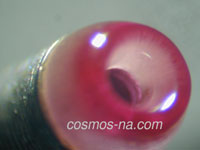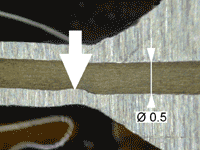

Coil Winding Nozzle - Ruby Tipped
Air Wipes
Bow Guides
Eyelet Guides
Nozzle Guides
Pulleys
Ring Guides
Rods
Roller Guides
Snail Guides
Tube Guides
U- Guides
Welding Butts
Surface Finish
Glossary
Inquiry Forms
Materials
Site Map
Ruby is the Hardest
 Ruby and Sapphire are the hardest materials among the
Ruby and Sapphire are the hardest materials among the
ultra-hard materials selected to make wire guide nozzles. Their mono crystalline (that is, a single crystal) structure allows for diamond polishing to a mirror finish unmatched by other material, reducing friction and protecting the wire. For this reason, ruby and sapphire were materials of choice for nozzle exit and entrance in the early days of the coil winding industry - and they continued to be, where minimum friction is the predominant concern. Shown at right is a photomicrograph of a ruby exit orifice.
Technical Data
Hardness value: 1,800 – 2,200 Vickers, or 3 times that of case hardened steel
Surface roughness: 0.025 – 0.05 microns, or 1 – 2 micro inches Ra
Tip I. D. Choice of 0.3, 0.5, 0.6, 0.7, 0.8, 1.0, 1.2, 1.4, 1.8 mm
Body material: Steel; usually stainless steel for structural support, not hard
Outside diameter: 0.5 – 4.0 mm, wall thickness governing
Length: 10 – 50 mm, aspect ratio governing
Young"s modulus: 190 - 210 MPa
A Word of Caution
Don't reclaim and reuse wire guide nozzles which have been bent,
the consequences could be catastrophic!
All seamless steel tubes are hard drawn, imparting a rough bore surface. Earnest endeavors have been devised to improve bore roughness in the steel tubes, yet results have failed to match that of ruby, sapphire, tungsten carbide. The photo below reveals, among other things, an example of a stainless steel wire guide nozzle bore surface which is hardly smooth, and grossly inferior to the ruby or sapphire element(s) which they support.
The Young's modulus of steel is only 1/3 - 1/2 that of tungsten carbide, which means steel is more flexible, or less stiff, in keeping the exit concentric to the locating diameter.
 Due to the flexibility of steel tubes, they bend upon impact instead of breaking – an unfortunate yet unavoidable mishap on the shop floor. Operators without preventive instructions are inclined to reuse the bent wire guide nozzle, provided it is not beyond repair, unaware that permanent deformation has occurred upon impact (see bulge at right). Insulation is impaired by the bulge and may go undetected, only to manifest itself years after the coil has been put into service, resulting in millions of recalls and replacements.
Due to the flexibility of steel tubes, they bend upon impact instead of breaking – an unfortunate yet unavoidable mishap on the shop floor. Operators without preventive instructions are inclined to reuse the bent wire guide nozzle, provided it is not beyond repair, unaware that permanent deformation has occurred upon impact (see bulge at right). Insulation is impaired by the bulge and may go undetected, only to manifest itself years after the coil has been put into service, resulting in millions of recalls and replacements.